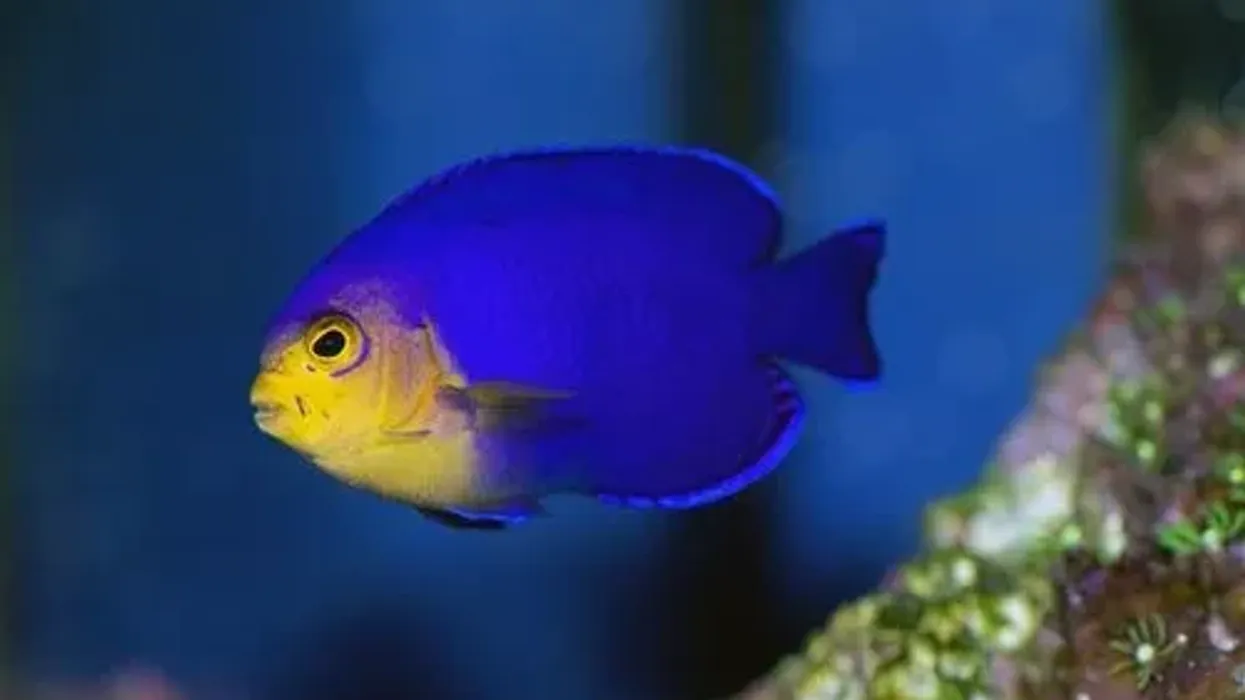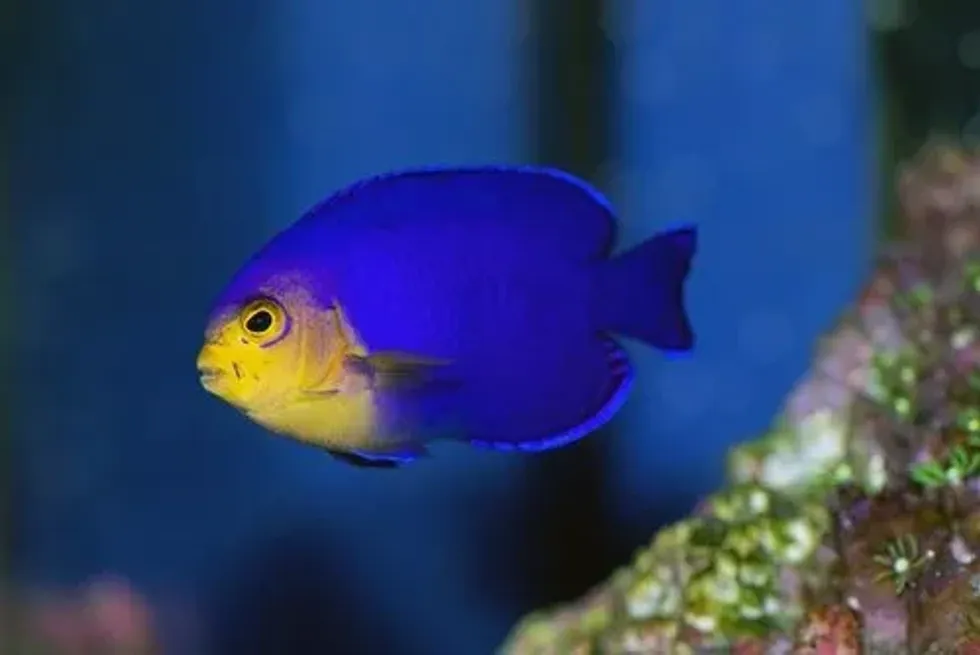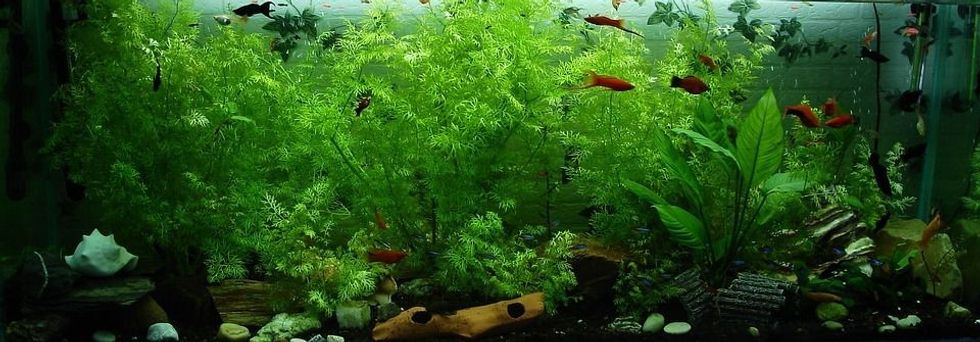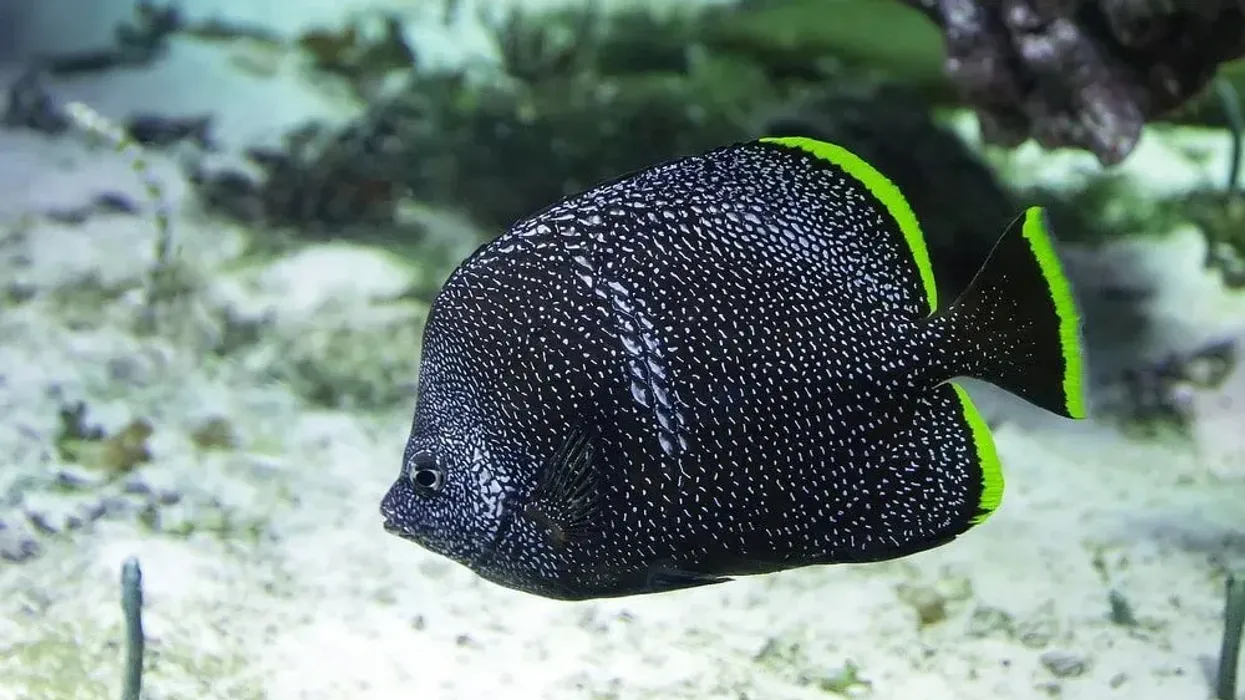The cherubfish (Centropyge argi) is a little fish from the Pomacanthidae family. It is found in the western Atlantic Ocean.
As far east as French Guiana, it can be found off Bermuda, in the Caribbean Sea and the Gulf of Mexico, as well as the Caribbean coast of South America. Its habitat is the coral rubble.
When mature, this species is capable of spawning readily. They clean vertical surfaces before laying their eggs evenly and scare away other fish.
An egg is laid on a ready facade, which is later fertilized by the male during spawning. Breeding can occur between 6-12 months of age in angelfish.
For breeding Angelfish, the freshwater aquarium needs to be large enough. There is a deep, oval, and compressed shape to their body. A long, robust spine runs along the angle of the preoperculum, serrated on the vertical edge.
Body-color is deep blue, head and chest are orange-yellow with dark blue lines around the mouth and eyes. Yellowfins cover the pectoral fins, and dark blue fins have light blue margins on the other fins.
A cherub angelfish tank size must be around 50 gall (189.3 l) to be able to absorb the nutrients. It's not a good idea to keep them in a nano tank because they are territorial!
They are also characterized by the highest aggression per inch, which allows for a larger tank. The little monsters will attack docile fish such as flasher wrasses, gobies, and firefish.
If you like reading about the cherubfish, you might also like the altum angelfish and the angelfish.
Cherubfish Interesting Facts
What type of animal is a cherubfish?
The cherubfish (Centropyge argi) is a marine ray-finned fish from the Pomacanthidae family.
What class of animal do the cherubfish belong to?
The cherubfish (Centropyge argi), also known as the pygmy angelfish, is a little fish from the marine angelfish species of genus Centropyge.
How many cherubfish are there in the world?
The exact estimation of the cherubfish population is unknown, but it seems to be in a stable state.
Where does the cherubfish live?
Cherubfish (pygmy angelfish) inhabits the western Atlantic Ocean. As far east as French Guiana, this little fish can be found off Bermuda, in the Caribbean Sea and the Gulf of Mexico, as well as the Caribbean coast of South America. They are kept as pets in a tank or an aquarium.
What is a cherubfish habitat?
Cherubfish typically lives between 16-59 ft (4.9-18 m) deep, below 98 ft (29.9 m). The coral rubble is its usual habitat, and its primary food source is algae and benthic invertebrates. Alarming, it causes it to retreat into caves.
Who does the cherubfish live with?
A single male and several female fish and juveniles usually make up a small group of around ten fish.
How long does a cherubfish live?
The lifespan of cherubfish is about five years in captivity in an aquarium or a reef tank.
How do they reproduce?
The pygmy angelfish are capable of spawning readily when mature. In order to lay their eggs evenly on a vertical surface, they clean it and scare away other fish.
During spawning, the female lays many eggs on a ready facade, which the male then fertilizes. An angelfish can breed at any age between 6-12 months of age.
The freshwater aquarium we need for breeding Angelfish must be of large size. In order to encourage spawning, a taller tank or an aquarium and a proper lighting schedule are needed.
By first turning off half of the lights (brighter light), then the other half an hour later (actinic lights) at a consistent time every day, you can mimic the proper dusk light cycle your aquarium has.
It takes just over a day for the eggs to hatch. The tiny mouths of hatchlings require microscopic algae within days of hatching.
What is their conservation status?
The cherubfish has to be listed as the Least Concern under the IUCN Red List of endangered species.
Cherubfish Fun Facts
What does the cherubfish look like?
The description of a cherubfish is a long, blunt snout and a small mouth. Their body is oval, deep, and laterally compressed.
The preoperculum has a long, robust spine at its angle, which is serrated along its vertical edge. Body-color is deep blue, head and chest orange-yellow with a dark blue bridge of the mouth and a thin blue band around the eyes.
There are pale yellowfins on the pectoral fins and darker blue fins with light blue margins on the other fins.
There are 14-15 spines and 16-17 soft rays on the dorsal fin, while there are three spines and 17 soft rays on the anal fin. The maximum length of this species is 3.1 in (8 cm).
How cute are they?
Yes, they are cute. The fins of these fish are tall, pointed, and have beautiful, shimmering scales. A variety of colors are sometimes seen on Marine Angelfish, including red, gray, blue, and yellow. Fish in freshwater can have silvery-blue colors and dark longitudinal stripes.
How do they communicate?
Pygmy angelfish utilize chemical signals carried in their urine and bile to communicate their social status. They provide camouflage in coral reefs and are important for communication because of their bright-colored bodies.
How big is the cherubfish?
The cherubfish is 6-8 in (15.2-20.3 cm) in size.
How fast can a cherubfish swim?
As pygmy angelfish are slow swimmers, they cannot handle strong currents in the water, so water currents in the tank or an aquarium should be kept to a minimum.
How much does a cherubfish weigh?
The cherubfish weighs 2 lb (0.9 kg).
What are the male and female names of the species?
There are no specific names for the separate sexes of cherubfish. They are simply referred to as the female cherubfish and the male cherubfish.
What would you call a baby cherubfish?
The baby cherubfish is called a fry.
What do they eat?
The Atlantic Pygmy Angelfish is an omnivorous fish in the wild, feeding on various algae, benthic invertebrates, and their waste products. First, if they are kept in an aquarium, their diet must be taken care of properly.
Angelfish will take any food offered to him and graze on algae found on live rock. With frozen foods and some microalgae growth in the tank or an aquarium, they do well on Spirulina algae, mysid shrimp, shaved shrimp, and marine algae.
Are they dangerous?
Cherub Angelfish (Centropyge argi) are very aggressive fish, so place them in a reef tank or aquarium with more aggressive fish. Despite being more aggressive in small tanks, Pygmy Angelfish will still hunt smaller tank mates regardless of size.
Those who are docile will be harassed to death even by their own tankmates. The males of two Pygmy Dwarf Angel will also battle to the death.
When a Centropyge angelfish is kept in a tank or aquarium over 100 gallons with plenty of hidey-hole, it will not get along with another one. Reef fishes are generally good.
Would they make a good pet?
Yes, they are kept as pets in reef tanks and aquariums. First, you must consider purchasing an angelfish that is alert, active, and interested in its surroundings when purchasing this species.
Theiur color should be rich and not faded, and they should be difficult to catch. Scale areas should not be reddened or bloated.
Keeping one pair of male and female cherubfish or two females will require a tank that holds at least 75 gall (283.9 l). The parameters for the water should be 72-82°F (22.2-27.8°C), pH 8.3-8.4, and sg 1.018-1.025.
Several rock caves make it easy for this pygmy angel to hide and pick up natural food from rubble areas. This species can attack docile fish, so introductions should be made as to the last inhabitants into an established tank.
With frozen foods and some microalgae growth in the tank, they do well on Spirulina algae, mysid shrimp, shaved shrimp, and marine algae. Unless there are natural foods in the aquarium, feed three times a day, they are semi-aggressive and must be kept with similar species.
Did you know...
Centropyge argi are all born female. Eventually, the dominant and largest fish will become male, while the small, less dominant fish will remain female.
As a result of his death, the next in command in the hierarchy will be a male. The best way to get a pair is to put two fish together, maybe in two months, give or take. Sex is not determined by color.
What are the tank mates of cherubfish?
The cherub angelfish tank mates compatible with it will be peaceful small fishes like gobies, dartfish, assessors, fairy wrasses, semi-aggressive ones like anthias, clownfish, dwarf angels, and some aggressive ones as dottybacks, wrasse, damselfish, tangs, large angels, large wrasses, lionfish, groupers, and soapfish.
Some other tank mates can be sea horses, soft or hard corals, little polyps, sponges, shrimps, crabs, snails, oysters.
Are cherubfish reef safe?
This species is not reef safe, it will attack stony corals and clamshells.
Here at Kidadl, we have carefully created lots of interesting family-friendly animal facts for everyone to discover! For more relatable content, check out these angelfish and french marine angelfish.
You can even occupy yourself at home by coloring in one of our free printable fish coloring pages.
Main image by Brian Gratwicke.









